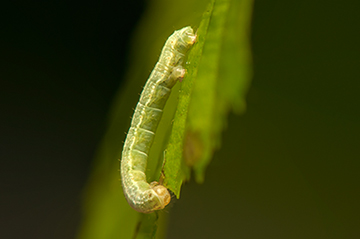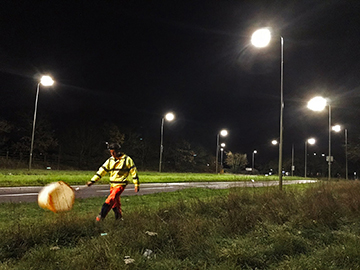
Operophtera brumata caterpillar. A study in the United Kingdom suggested that white-light LED streetlights are more detrimental to populations of these and other caterpillars than other lamps, a pattern with potential impacts on ecosystem processes as LED street lighting increases. [Image: Gucio_55/Getty Images]
The invention of the blue LED in the early 1990s spurred a gradual worldwide switch from incandescent bulbs and other traditional light sources to more efficient, long-lasting LED lamps. One area of rapid adoption is street lighting, where LED technology continues to replace high-pressure sodium light sources that contain mercury, glow yellow and require a long warm-up time.
Now, researchers from the United Kingdom have discovered unintended negative consequences of LED streetlights on insect populations (Sci. Adv., doi: 10.1126/sciadv.abi8322). Their experiments reveal that LEDs reduce caterpillar abundance and disrupt feeding behavior more than sodium bulbs, suggesting that the ongoing shift towards LED outdoor lighting could translate to detrimental effects for ecosystem processes.
The harms of artificial light
In recent decades, studies have found that terrestrial insect populations have noticeably decreased, a pattern that has repercussions for other species that feed on them. For example, the total abundance of moths in Britain has decreased by one third over the past 50 years, leaving less food for songbirds, who typically consume hundreds of caterpillars a day.
Along with climate change and habitat loss, light pollution has been proposed as a contributing factor to the insect population reductions. Previous research has indicated that artificial light at night may inhibit adult activity, disturb reproduction and leave insects more open to predators.
“The impacts of nighttime lighting is a relatively neglected area of research,” said study author and entomologist Douglas Boyes of the UK Center for Ecology & Hydrology (UKCEH). “With growing evidence of worrying declines in insect population from some parts of the world, we were keen to determine if street lighting may be an important factor.”
Disrupted biological processes

Sampling nocturnal caterpillars in grass margins using a sweep net (under white LED street lights). Location: Golden Balls Roundabout, Oxfordshire. [Image: Jacob Jaffe]
Boyes and his colleagues focused on nocturnal moth caterpillars, since they are far less mobile than their adult counterparts and would better represent local effects. Over the past three years, they spent more than 400 hours sampling for caterpillars along roadsides at more than 50 lit and unlit sites in the Thames Valley.
The results showed that the abundance of caterpillars in hedgerows under LED street lights was 52% lower than in nearby unlit areas, compared to 41% lower under sodium lighting. Along the edges of grass fields, numbers of caterpillars under LEDs were one-third lower than in unlit areas, whereas sodium lights had little effect on population. A separate experiment with lighting rigs along previously unlit grass fields found that LED lighting disrupted normal feeding behavior, while sodium lights did not.
“Sodium lights have yellow hue, and largely lack blue light, which insects are most sensitive to,” said Boyes. “The color of white LEDs is also much more similar to daylight than sodium lights, so biological processes that are controlled by daylight are predicted to be more readily disrupted.”
As a possible solution, the researchers recommend reducing the intensity of LED streetlights through dimming, as well as using filters to reduce blue wavelengths of light that are most harmful to insects.
